Another Look At Ultrarich Preppers: How Would Their Methods Work? (Part 1)
Two days ago, I commented on a lengthy expose article in the New Yorker on the hidden world of rich Wall-Street and Silicon-Valley preppers. Therein, I treated it as a sociological phenomenon.
Now, I'll be commenting on the methods they've settled upon. I don't have any real first-hand experience in prepping, over and above storing lots of food (and coffee!), so I'll be relying upon what I've read and general knowledge. This part deals with the first method, after a discussion of a noteworthy omission from the article.
Sidebar: The Noteworthy Lacuna - Why No Mention Of EMP?
I was surprised to see no mention of prepping for an electromagnetic pulse event or EMP attack. The threat of an EMP is pretty basic knowledge in the prepper world: you don't have to dive in all that deep to see one or more prepper(s) discussing it. At least two widely-read disaster novels, the best-selling One Second After and the underground classic Lights Out, have used an EMP attack to kick off their respective plots.
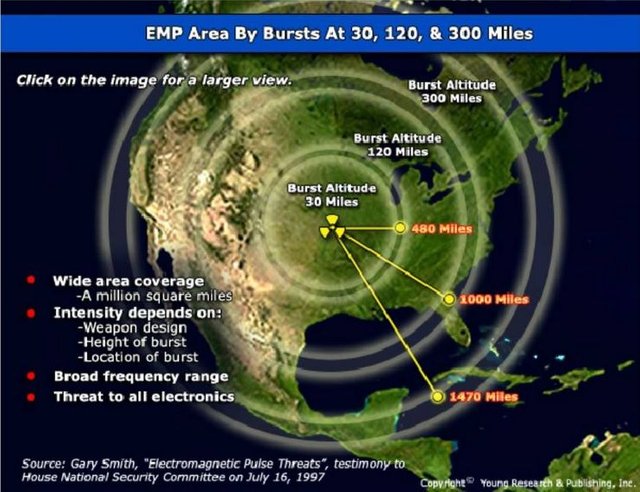
In fact, EMP is taking the place of a nuclear holocaust as the mainstay of post-apocalyptic fiction. The world found out after the Carrington Effect of 1859 that a powerful electromagnetic pulse can fry electrical equipment. Electronic equipment, especially computers, are even more vulnerable unless shielded. There's some controversy over how many electrical and electronic devices would be fried beyond repair by an EMP attack, but it's clear that a lot of them would.
For one, unshielded transformers that carry grid power into homes will be fried. Since these devices are batch-made, part of the grid could be down for a few years after an EMP attack.
The above makes an EMP attack even more scary than a nuclear holocaust. Plain common sense says that winning a thermonuclear war would be a Pyrrhic victory. What semi-sane conqueror want to take over a 'prize' where lots of the best locations are Chernobyl style no-go zones? Thirty years after that disaster, the bulk of the Chernobyl zone is still uninhabitable. Its "exclusion zone" is two thousand six hundred square kilometers big. The radiation poured out was in line with the radiation that would be emitted by a huge (> 10 megaton) H-bomb.
Obviously, a nation with several (let alone a double-digit number) of exclusion zones would not be much of a prize at all. This consideration, plus the inevitable pounding that the winner would have suffered by the loser's H-bombs, kept the urge to launch a nuclear attack safely throttled.
This is not the case with an EMP attack. If executed properly, a nuclear EMP blast could inflict the same casualties and chaos that a nuclear strike could - without rendering any of the land uninhabitable.
Moreover, a nuclear EMP is a glaring example of an asymmetric attack. All it takes is one well-prepared and properly-deployed bomb, at most several, for virtually all of the North American continent to suffer. Hypothetically, a piss-ant state like North Korea could humble the United States with an EMP attack.
The above means that an EMP disaster is more intellectually grabbing than a nuclear-holocaust scenario. That's why it's odd that the New Yorker article didn't even mention it in passing. My best guess? The interviewees are aware, but kept their mouths shut about it.
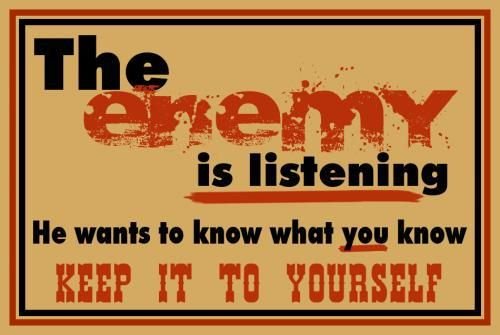
Not that those fine folks consider the New Yorker reporter to be an enemy, of course. Perish the thought. ;)
Rich Prepper Methods: The Evaluation
1. Sheltering In Place: Bugging In
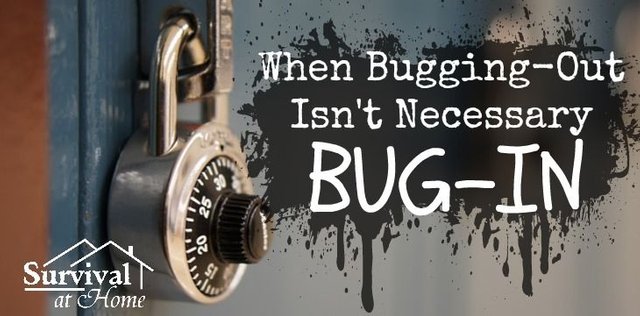
For all disasters below and beneath an all-out SHTF nightmare where the rule of law breaks down, bugging-in is the best choice. Disasters at this level, including power outages or weather-related carnage, are best prepared for by stocking up supplies, installing off-grid options for electricity and heat (if necessary), making sure you have a big supply of water that can be made potable by a high-quality water filter (good excuse for a swimming pool!), and so on: this is the best plan to get through a sub-apocalyptic disaster.
I've experienced two long-lasting power outages in Toronto, one in the summer and one in the winter (caused by an ice storm.) In both cases, folks turned inwards and toughed it through. Emergency personnel managed to put together heating stations (for the winter outage) and everyone got through fine - even the folks who went without power for days. Some of them moved in with family or friends in areas where power was restored quickly. There were no traffic jams.
From what I've read of Americans afflicted by like disasters, they do not panic or turn on each other. Instead, they help each other.
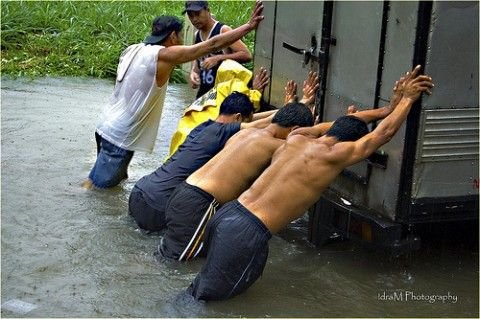
"Regular" disasters like these are best handled by sheltering in place for this one overarching reason: they don't last all that long. For most of them, life returns to close-to-normal within a week. The worst parts hit, the slowest to be repaired, go back to normal in less than three weeks.
So there's no compelling need to head out to the proverbial woods. Outfitting your place to get by for a month's worth of grid- and shopping-free life, making sure you have enough supplies for a month (don't forget the toilet paper!) and enough fuel for a month to run a generator if you need non-solar electricity, will get you through a tight spot that lasts longer than even the worst stretch of disaster I've come across. Also, given that panic-and-riot is a Hollywood-fueled urban legend not based in fact, any breakdown of law and order will not be as extensive as some fear. Everyone knows, many through experience, that disasters of this sort are temporary. That will restrain folks who might well go feral in a true SHTF scenario, such as an EMP attack or an all-out civil war.
Realistically, the preps you need to defend and protect your property and family are no more than the ones you undertake to protect yourself from a crime wave.
There's another, operational-security, benefit to bugging-in: your property does not look like it's been abandoned. As long as you're there and ready, you don't have much to fear from this guy:

There was widespread looting in New Orleans after Katrina, but a close look at those incidents shows that the bulk of them involved folks picking up property that was - or looked - abandoned. Your mere presence on your homestead will deter all of them except for real criminals. You'll almost surely get by with a few self-defense weapons and a watchful eye: the same prep and training that you'd take to defend yourself, your family and your domicile against ordinary thugs.
Lord knows you'll have enough spare time to keep an eye peeled....
(Images from here, here and here .)
Thanks for reading Part 1! The next part's coming soon.
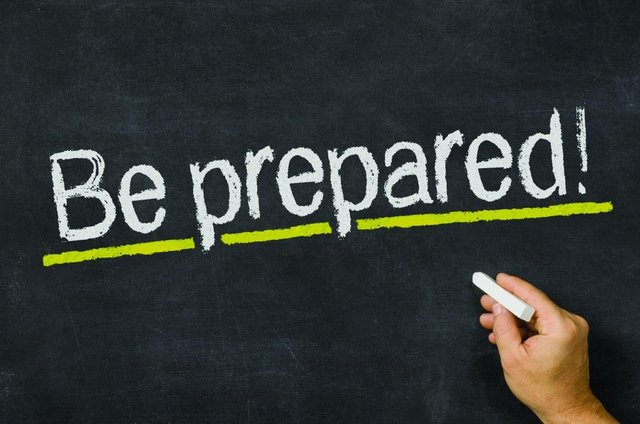
(Image from here.)
Another great post!
https://twitter.com/Soul_Eater_43/status/826223008113111040
Thanks a lot! I hope I live up to the billing.
Lol I'm sure you will!
looking forward to part 2 - resteemed
Thanks!
We watch what We Know.
Myself, I try to. Welcome to Steemit.
Great subject, thank you.
Glad to! Thanks for reading it.
An EMP attack is wonderful science-fiction.
However, it is not real.
Take your pretty picture of the affected area by altitude of detonation.
30, 120, 300 miles.
What you do not see there is that ... lets assume they had a device that would make an EMP that would take out computers at 30 miles away. And this is a big assumption.
The one at 120 miles would need to be (120^2 - 30^2) times more powerful.
13,500 times more powerful!!!
At 300 miles, it would need to be (300^2 - 30^2) = 89,910 times more powerful.
Energy transmission of this kind falls off at the square of the distance. And any of the EMP possible devices that I know of are across the street distances. Not even 30 miles.
Also, the electrical grid deals with nearby lightening strikes all the time. Real EMPs.
What will happen is thus: A black flag event. Detonate a large blast somewhere, then send a signal to shut down the electrical grid, computers and smartphones. (Yes, these all have a govern-cement back door to turn them off.) And then blame it on an EMP from whichever boogyman they wish.
That could be. But are you sure your math is right? Square-of-the-distance only applies when the energy is propagated in all directions. (For example: it would apply perfectly to an H-bomb detonated in outer space.)
If that math were to hold up, the area of the 120-miler would be much larger than the 30-miler. Since it isn't, there's a focusing effect that's in play.
Here's what Wikipedia has to say:
https://en.wikipedia.org/wiki/Nuclear_electromagnetic_pulse